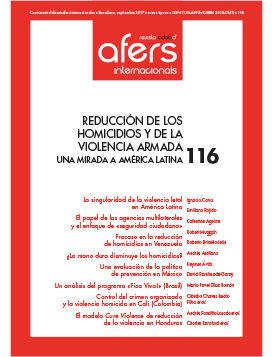El modelo Cure Violence: reducción de la violencia en San Pedro Sula (Honduras)
Palabras clave:
San Pedro Sula, Honduras, tiroteos, homicidios, salud, Cure ViolenceResumen
Revista CIDOB d’Afers Internacionals, nº 116
Cuatrimestral (mayo-septiembre 2017)
ISSN:1133-6595 | E-ISSN:2013-035X
DOI: https://doi.org/10.24241/rcai.2017.116.2.179
Desarrollado en Estados Unidos, el modelo Cure Violence («Curar la Violencia») es un programa de control epidémico que reduce la violencia a través de cambios de normas y de comportamiento. Este artículo revisa, en primer lugar, la situación de violencia en Honduras y, en particular, en San Pedro Sula que, durante años, fue la ciudad con mayores tasas de homicidios del mundo. Para hacer frente a esta situación, en 2013 comenzó a implementarse en algunas zonas de la ciudad una adaptación del programa. Así, tras detallar la adaptación del modelo al contexto de la ciudad hondureña, se analizan sus resultados en dos períodos de 2014 y 2015 (frente a 2013 y 2014, respectivamente), entre los que destacan una reducción significativa de los tiroteos y una reducción menor en las cifras de homicidios.
Citas
Abt, Thomas y Winship, Christopher. What Works in Reducing Community Violence: A Meta-Review and Field Study for the Northern Triangle. Bethesda: USAID, 2016, (en línea) [Fecha de consulta: 12.14.2016] https://www.usaid.gov/sites/default/files/USAID-2016-What-Works-in-Reducing-Community-Violence-FinalReport.pdf
Anderson, Elijah. Code of the street: Decency, violence, and the moral life of the inner city. Nueva York: W. W. Norton & Company, 2000.
Archer, Dane y Gartner, Rosemary. «Violent acts and violent times: A comparative approach to postwar homicidio rates». American Sociological Review, vol. 41, n.º6 (1976), p. 937-963.
Bandura, Albert. Social Learning Theory. Englewood Cliffs, NJ: Prentice Hall, 1977.
Bandura, Albert y Huston, Aletha C. «Identification as a process of incidental learning». The Journal of Abnormal and Social Psychology, vol. 63, n.º 2 (1961), p.311-318.
Bingenheimer, Jeffrey B.; Brennan, Robert T. y Earls, Felton J. «Firearm violence exposure and serious violent behavior». Science, vol. 308, n.º 5.726 (2005), p.1.323-1.326.
Black, David S.; Sussman, Steve y Unger, Jennifer B. «A further look at the intergenerational transmission of violence: Witnessing interparental violence in emerging adulthood». Journal of Interpersonal Violence, vol. 25, n.º 6 (2010), p.1.022-1.042.
Buhaug, Halvard y Gleditsch, Kristian Skrede. «Contagion or confusion? Why conflicts cluster in space». International Studies Quarterly, vol. 52, n.º 2 (2008), p.215-233.
Butts, Jeffrey A.; Wolff, Kevin T.; Misshula, Evan Delgado, Sheyla. Effectiveness of the Cure Violence Model in New York City [Research Brief 2015-01]. Nueva York: John Jay College of Criminal Justice, Research & Evaluation Center, 2015.
Centers for Disease Control and Prevention. Violence Against Children Survey (VACS). Centers for Disease Control and Prevention, 2015 (en línea) https://www.cdc.gov/violenceprevention/vacs/
Christakis, Nicholas A. y Fowler, James H. Connected: The surprising power of our social networks and how they shape our lives. Boston: Little, Brown, 2009.
Cohen, Jacqueline y Tita, George. «Diffusion in homicide: Exploring a general method for detecting spatial diffusion processes». Journal of Quantitative Criminology, vol. 15, n.º 4 (1999), p. 451-493.
Coleman, Diana Lewis y Slutkin, Gary. «Chemoprophylaxis against tuberculosis». Western Journal of Medicine, vol. 140, n.º 1 (1984), p.106-110.
Delgado, Sheyla; Butts, Jeffrey A. y Alsabahi, Laila. Perceptions of Violence in Bedford-Stuyvesant (Brooklyn) [Research Brief 2015-06]. Nueva York: John Jay College of Criminal Justice, Research & Evaluation Center, 2015a.
Delgado, Sheyla; Butts, Jeffrey A. y Alsabahi, Laila. Perceptions of Violence in South Bronx [Research Brief 2015-06]. Nueva York: John Jay College of Criminal Justice, Research & Evaluation Center, 2015b.
Delgado, Sheyla; Butts, Jeffrey A. y Alsabahi, Laila. Perceptions of Violence in Harlem [Research Brief 2015-06]. Nueva York: John Jay College of Criminal Justice, Research & Evaluation Center, 2015c.
Delgado, Sheyla; Butts, Jeffrey A. y Alsabahi, Laila. Perceptions of Violence in East New York (Brooklyn) [Research Brief 2015-06]. Nueva York: John Jay College of Criminal Justice, Research & Evaluation Center, 2015d.
Delgado, Sheyla; Butts, Jeffrey A. y Alsabahi, Laila. Perceptions of Violence in Morrisania (The Bronx) [Research Brief 2015-06]. Nueva York: John Jay College of Criminal Justice, Research & Evaluation Center, 2015e.
Delgado, Sheyla; Butts, Jeffrey A. y Alsabahi, Laila. Young Men in Neighborhoods with Cure Violence Programs Adopt Attitudes Less Supportive of Violence [Research Brief 2017-01]. Nueva York: John Jay College of Criminal Justice, Research & Evaluation Center, 2017.
Egeland, Byron; Jacobvitz, Deborah y Sroufe, L. Alan. «Breaking the cycle of abuse». Child development, vol. 59, n.º 4 (1988), p. 1.080-1.088.
Ehrensaft, Miriam K.; Cohen, Patricia; Brown, Jocelyn; Smailes, Elizabeth; Chen, Henian; Johnson, Jeffrey G.. «Intergenerational transmission of partner violence: a 20-year prospective study». Journal of consulting and clinical psychology, vol. 71, n.º 4 (2003), p. 741-753.
Fowler, Patrick J.; Tompsett, Carolyn J.; Braciszewski, Jordan M. ; JacquesTiura, Angela J. y Baltes, Boris B. «Community violence: a meta-analysis on the effect of exposure and mental health outcomes of children and adolescents». Development and Psycopathology, vol. 21, n.º 1 (2009), p. 227-259.
Gagne, David. «Is Honduras Faking its Falling Homicide Rates?». InSight Crime (13 de agosto de 2014) (en línea) http://www.insightcrime.org/newsbriefs/honduras-faking-falling-homicide-rates
Gagne, David. «Murders Down but Massacres On the Rise in Honduras». InSight Crime (2 de diciembre de 2015) (en línea) http://www.insightcrime.org/news-briefs/murders-down-but-massacres-on-the-rise-in-honduras
Gould, Madelyn S.; Wallenstein, Sylvan y Kleinman, Marjorie. «Time-space clustering of teenage suicide». American Journal of Epidemiology, vol. 131, n.º 1 (1990), p. 71-78.
Gould, Madelyn S.; Greenberg, Ted; Velting, Drew M. y Shaffer, David. «Youth Suicide Risk and Preventive Interventions: A Review of the Past 10 Years». Journal of the Academy of Child and Adolescent Pysychiatry, vol. 42(2003), p. 386-405.
Guerra, Nancy G.; Huesmann, L. Rowell y Spindler, Anja. «Community violence exposure, social cognition, and aggression among urban elementaryschool children». Child Development, vol. 74, n.º 5 (2003), p. 1.507-1.522.
Henry, David; Knoblauch, Shannon y Sigurvinsdottir, Rannveig. The Effect of Intensive Cure Violence Intervention on Crime in Four Chicago Police Beats: Quantitative Assessment. Chicago: Robert R. McCormick Foundation, 2014.
Heymann, David. Control of communicable diseases manual. Washington: American Public Health Association, 2008.
InSight Crime y Asociacion para una Sociedad más Justa. Gangs in Honduras. USAID, 2015 (en línea) [Fecha de consulta: 12.14.2016] http://www.insightcrime.org/images/PDFs/2015/HondurasGangs.pdf
IOM-Institute of Medicine. Contagion of Violence: Workshop Summary. Washington,DC: The National Academies Press, 2013.
Kelly, Sarah. «The psychological consequences to adolescents of exposure to gang violence in the community: an integrated review of the literature». Journal of Child and Adolescent Psychiatric Nursing, vol. 23, n.º 2 (2010), p. 61-73.
Krug, Ethienne G.; Dahlberg, Linda L.; Mercy, James A.; Zwi, Anthony B. y Lozano, Rafael (eds.). World report on violence and health. Ginebra: World Health Organization, 2002.
MacManus, Deirdre; Dean, Kimberlie; Jones, Margaret; Rona, Roberto; Greenberg, Neil; Hull, Lisa; Fahy, Tom; Wessely, Simon y Fear, Nicola. «Violent offending by UK military personnel deployed to Iraq and Afghanistan: a data linkage cohort study». The Lancet, vol. 381, n.º 9870 (2013), p. 907-917.
McDonnell, Jerome. «Cure Violence employs public health methodology to fight urban violence» [Audio Podcast]. WBEZ 91.5 Chicago, (24 de agosto de 2011) [Fecha de consulta: 12.14.2016] http://www.wbez.org/episode-segments/2011-08-24/CureViolence-employs-public-health-methodology-fighturban-violence-90962
Moser, Caroline y Winton, Ailsa. «Violence in the Central American region: towards an integrated framework for violence reduction». Working paper, n.º171. Londres: Overseas Development Institute, 2002.
Mullins, Christopher W.; Wright, Richard y Jacobs, Bruce A. «Gender, streetlife and criminal retaliation». Criminology, vol. 42, n.º 4 (2004), p. 911-940.
Newman, M. Sophia. «Can a Chicago Cure for Violence Make a Man Stop Beating His Wife?». Pulitzer Center, 8 de junio de 2015 (en línea) http://pulitzercenter.org/reporting/can-chicago-cure-violence-make-man-stop-beating-his-wife
Ortega, José A. «Por tercer año consecutivo, San Pedro Sula es la ciudad más violenta del mundo». Seguridad, Justicia y Paz. Consejo ciudadano para la seguridad pública y justicia penal A.C. (15 de enero de 2014) (en línea) [Fecha de consulta: 12.14.2016] http://www.seguridadjusticiaypaz.org.mx/sala-deprensa/941-por-tercer-ano-consecutivo-san-pedro-sula-es-la-ciudad-masviolenta-del-mundo
Perez-Stable, Eliseo J. y Slutkin, Gary. «A demonstration of lack of variability among six tuberculin skin test readers». American Journal of Public Health, vol. 75, n.º 11 (1985), p. 1.341-1.343.
Perez-Stable, Eliseo J.; Slutkin, Gary; Paz, Antonio y Hopewell, Philip C. «Tuberculin reactivity in United States and foreign-born Latinos: results of a community-based screening program». American Journal of Public Health, vol. 76, n.º 6 (1986), p. 643-646.
Picard-Fritsche, Sarah y Cerniglia, Lenore. Testing a Public Health Approach to Gun Violence. Nueva York: Center for Court Innovation, 2013.
Ransford, Charles L.; Kane, Candice y Slutkin, Gary. «Cure Violence: A Disease Control Approach to Reduce Violence and Change Behavior», en: Waltermaurer, Eve y Akers, Timothy (eds.). Epidemiological Criminology: Theory to Practice. Abingdon y Nueva York: Routledge, 2013, p. 232-242
Schwab-Stone, Mary; Ayers, Tim; Kasprow, Wesley; Voyce, Charlene; Barone, Charles; Shriver, Timothy y Weissberg, Roger. «No Safe Haven: A study of violence exposure in an urban community». Journal of the American Academy of Child and Adolescent Psychiatry, vol. 34, n.º 10 (1995), p. 1.343-1.352.
Seguridad, Justicia y Paz. «Caracas, Venezuela, la ciudad más violenta del mundo del 2015». Seguridad, Justicia y Paz. Consejo ciudadano para la seguridad pública y justicia penal A.C. (25 de enero de 2016) (en línea) [Fecha de consulta: 12.14.2016] http://www.seguridadjusticiaypaz.org.mx/sala-de-prensa/1356-caracas-venezuela-la-ciudad-mas-violenta-del-mundodel-2015
Sherman, Lawrence W.; Gartin, Patrick R. y Buerger, Michael E. «Hot spots of predatory crime: Routine activities and the criminology of place». Criminology, vol. 27, n.º 1 (1989), p. 27-56.
Skogan, Wesley; Harnett, Susan. M.; Bump, Natalie y DuBois, Jill. Evaluation of CeaseFire-Chicago. Chicago: Northwestern University Institute for Policy Research, 2009.
Slutkin, Gary. «Management of tuberculosis in urban homeless indigents». Public Health Reports, vol. 101, n.º 5 (1986), p. 481-485.
Slutkin, Gary. «Violence Is a Contagious Disease», en: Institute of Medicine and National Research Council. Contagion of Violence: Workshop Summary. Washington, D.C.: The National Academies Press, 2013a, p. 94-111.
Slutkin, Gary. «Treatment of Violence as an Epidemic Disease», en: John Snow’s Legacy, Epidemiology Without Borders [review]. The Lancet, vol. 381, n.º 9874 (2013b), p. 1.302-1.311.
Slutkin, Gary. «Reducing Violence: The Next Great Public Health Achievement». Nature Human Behavior, vol. 1, n.º 1 (2017) (en línea) https://www.nature.com/articles/s41562-016-0025
Slutkin, Gary; Okware, Sam; Naamara, Warren; Sutherland, Don; Flanagan, Donna; Carael, Michel; Blas, Erik; Delay, Paul y Tarantola, Daniel. «How Uganda reversed its HIV epidemic». AIDS and Behavior, vol. 10, n.º 4 (2006), p. 351-360.
Slutkin, Gary; Ransford, Charles L.; Decker, Brent y Volker, Karen. «Cure Violence– An Evidence Based Method to Reduce Shootings and Killings». World Bank Paper. Washington, DC: World Bank Group, 2014.
Slutkin, Gary; Ransford, Charles L. y Decker, Brent. «Cure Violence–Treating Violent Behavior as a Contagious Disease», en: Maltz, Michael D. y Rice, Stephen K.(eds.). Envisioning Criminology: Researchers on Research as a Process of Discovery. Suiza: Springer, 2015, p. 43.56.
UNODC-United Nations Office on Drugs and Crime. Crime And Development In Central America. UNODC - Proyecto Illicit Market Studies (GLO/H93), 2007 (en línea) [Fecha de consulta: 12.14.2016] https://www.unodc.org/pdf/research/Central_America_Study_2007.pdf
UNODC-United Nations Office on Drugs and Crime. «Intentional homicides (per 100,000 people)». International Homicide Statistics database, Naciones Unidas (2013) (en línea) [Fecha de consulta: 12.14.2016] http://data.worldbank.org/indicator/VC.IHR.PSRC.P5?order=wbapi_data_value_2013+wbapi_data_value+wbapi_data_value-last&sort=desc
UNODC-United Nations Office on Drugs and Crime. Global study on homicide 2013: trends, contexts, data. Viena: United Nations Publications, 2014 (en línea) https://www.unodc.org/documents/data-andanalysis/statistics/GSH2013/2014_GLOBAL_HOMICIDE_BOOK_web.pdf
Vice News. «San Pedro Sula Nights». Vice News, 8 de enero de 2015 (en linea) [Fecha de consulta: 12.14.2016] https://news.vice.com/video/san-pedro-sulanights
Webster, Daniel W.; Whitehill, Jennifer M.; Vernick, Jon S. y Parker, Elizabeth. M. Evaluation of Baltimore’s Safe Streets Program: Effects on Attitudes, Participants’ Experiences, and Gun Violence. Baltimore: Johns Hopkins Center for the Prevention of Youth Violence, 2012.
WHO-World Health Organization. Global status report on violence prevention 2014. Luxemburgo: WHO, 2014.
Widom, Cathy Spatz. «The cycle of violence». Science, vol. 244 (1989), p.160-166.
Wilkinson, Deanna; Kurtz, Ellen y Weldon, Arielle. «A Close Examination of the Social Worlds of Intentionally Injured Philadelphia Youth: Survey Results from a Hospital-Based Sample». William Penn Foundation, 2006.
Yagoub, Mimi. «What’s Behind Honduras’ 30% Drop in Murder Rates?». InSight Crime (19 de febrero de 2016) (en línea) http://www.insightcrime.org/newsbriefs/what-behind-honduras-30-percent-drop-murder-rates
Zeoli, April M.; Pizarro, Jesenia M.; Grady, Sue C. y Melde, Christopher. «Homicide as Infectious Disease: Using Public Health Methods to Investigate the Diffusion of Homicide». Justice Quarterly, vol. 31 (2012), p. 609-632. DOI: 10.1080/07418825.2012.732100
Zille, Helen y De Lille, Patricia. «Gang Violence: Western Cape Government and City of Cape Town Intervene». Western Cape Government, 19 de agosto de 2013 (en línea) [Fecha de consulta: 12.20.2016] https://www.westerncape.gov.za/news/gang-violence-western-cape-government-and-city-cape-town-intervene












